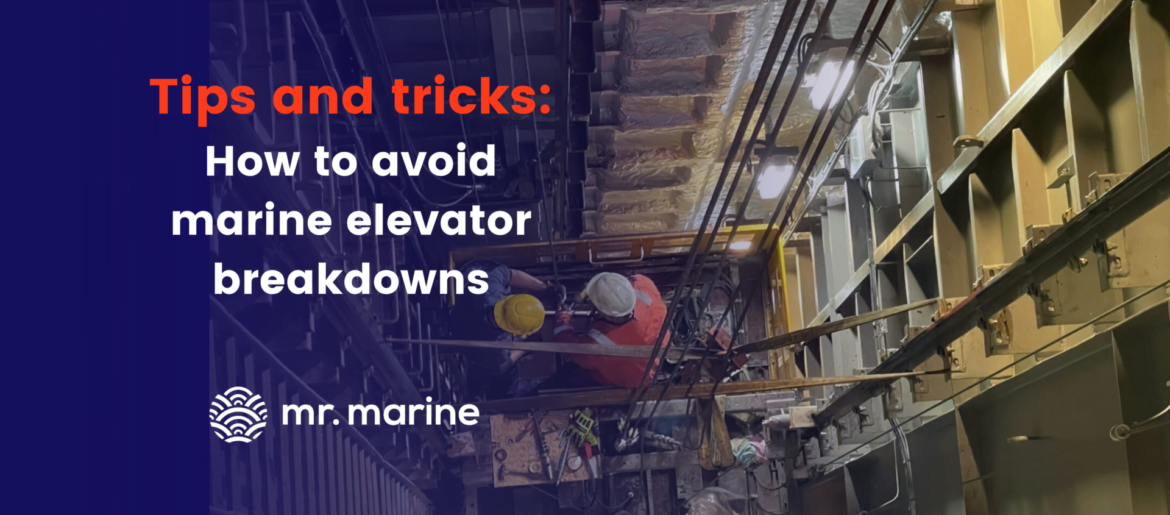Elevator problems are not always evident. Still, awareness of the common issues and preventive measures can help maintain your elevator operational.
First, it is essential to pay attention to maintenance. If there is a lack (or none) of maintenance, the performance of the marine elevator will reduce, and it will increase the probability of fatal errors along with:
- Higher operating costs (repairs after the breakdown are more costly than prevention)
- Less availability
- More complaints from users
- Most importantly: compromised safety
Most Frequent Breakdowns and Their Prevention
Some of the most common symptoms of a system malfunction are related to door contacts, interlock contacts, and door operator errors. As components wear and age, they tend to go out of adjustment, either shutting down the system or interfering with its operation. This situation is particularly relevant with the landing doors, car doors and door operators.
Door operators
Door operators undergo tremendous wear and tear in daily operations. Each time the marine elevator stops, the door operators are activated at least two times (more frequently if occupants manually hold the doors open). Also, the vessel’s vibration requires extra attention to the tightness and adjustment of the landing door locks and interlocks.
Fact: Nearly 75% of the service calls are for malfunctioning door operators.
If the number of service calls increases, consider replacing or upgrading the door operators. They are relatively easy to replace or upgrade without requiring significant downtime.
It is essential to track the frequency and costs of all problems by writing every error in a logbook. In this way, our service technician can trace the problem much easier.
Elevator doors
Dust, dirt and debris accumulate in the door tracks and sills, preventing elevator doors from opening smoothly. In the end, it will block the elevator doors from closing or fully opening. A simple and regular cleaning job will prevent downtime and save money.
Slippage
One of the possible causes of excessive slippage of ropes on the sheave can be the over-lubrication of the rope by greasing. The rope needs to have enough lubricant to eliminate friction in the wires and strands but not enough to cause slippage in the traction sheaves. It is advisable to use a special wire rope lubricant to penetrate the core.
Note: Governor ropes should never be re-lubricated
Most elevators have oilers fitted to dispense the lubricant for the car and counterweight guide rails and spoons in the pit to collect the excess oil. Empty oilers will result in dry friction and wear of the guide shoes, (at times) damaging the safety gears. It is a small task to top up the oilers, reducing wear, downtime, and servicing costs. Emptying the oil spoons/trays on time greatly reduces the slip hazard in the pit.
One extra advice
Consider also involuntary vandalism: a marine elevator can suffer vandalism or misuse without you knowing it. In the example of the doors, you should observe the following:
- Use the door open button to reopen the door instead of holding the door by hand or foot
- Do not keep the door open for a long period by blocking the safeguard
- If there is a preference key switch in the cabin, use it
- In case of hand-moved hinged doors: adjust the door closer in a way that the door does not “slam” shut
The elevator manuals contain important information, drawings and specifications. An elevator technician always refers to the manual before starting his work. With no manual available for reference, technicians have to spend extra time understanding the workings of an elevator’s specific and unique features. Keeping the complete manual in the machine room will help the technicians complete the service efficiently, thereby saving time.
Our technicians are always at your disposal, 24/7, with optimal solutions to meet your needs.
Do not hesitate to contact our team for your elevator service.
Read more about tips and tricks to avoid marine elevator breakdowns in our blog post:









